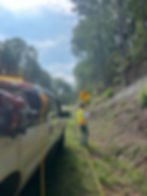Meeting OSHA Safety Standards in Vegetation Management Operations
- Kylie Myers
- Sep 29
- 4 min read

When it comes to commercial vegetation management in Georgia, staying ahead of storm prep, safety compliance, and late-season growth control isn’t just smart—it’s essential.
Clients expect not only clean, efficient results (such as in right-of-way vegetation control, storm damage vegetation cleanup, or vegetation management for utilities) but also a company that takes worker and public safety seriously.
At Ground Force, we pride ourselves on meeting—and exceeding—OSHA vegetation management safety standards in all of our operations across Georgia.
Storm Prep, Safety Compliance & Growth Control
When a facility manager, utility company, or municipality searches for terms like “storm damage vegetation cleanup” or “commercial vegetation management Georgia,” they usually have three priorities:
Storm readiness and cleanup – anticipating or responding to tree and brush damage after high winds, hurricanes, or ice storms.
Regulatory and safety compliance – ensuring that the work is done in a way that protects workers, the public, and property.
Seasonal growth control – especially in late season, when aggressive growth can encroach on right-of-way or utility zones.
Meeting those priorities means deploying best practices in safety, planning, and technical execution. Let’s walk through how OSHA safety standards guide our approach and how Ground Force applies them in real-world operations.
OSHA & Vegetation Management: A Patchwork of Standards
While there is currently no single USDA or federal standard labeled “vegetation management operations,” these things are regulated through a combination of OSHA’s general industry standards and more specialized rules.
Here are key areas that come into play:
Fall protection and aerial lifts: Employers must comply with OSHA’s Walking-Working Surfaces rules and the standard for vehicle-mounted elevating and rotating work platforms.
Personal Protective Equipment (PPE): Workers must wear appropriate gear—helmets, cut-resistant leg protection, eye and face protection, hearing protection, etc.
Electrical / line-clearance work: When vegetation work is near energized lines, standards and general electrical rules apply.
Tool maintenance & machine guarding: Chainsaws, chippers, stump grinders, and other equipment must be maintained and guarded per OSHA’s machinery and powered-tool standards.
First aid, fire protection, & emergency protocols: Worksites must have first-aid kits, trained responders on-site or quickly available, and fire extinguishers properly maintained.
Recordkeeping and the General Duty Clause: Serious injuries must be reported, illness/injury logs should be maintained, and employers have a duty to correct recognized hazards not directly addressed by a standard.
Vegetation work draws from multiple standards, which makes it challenging. So many different factors contribute to the overall approach, meaning companies that perform this work should be well-versed in the different guidelines and requirements.
How Ground Force Implements OSHA-Safe Practices
At Ground Force, we integrate OSHA- and industry-best practices into every stage of vegetation management—from planning to execution and through post-project review.
Risk Assessment & Site Planning
Before any job begins, we conduct a hazard assessment of the terrain, vegetation, electrical exposure, traffic, and weather.
For right-of-way vegetation control, we plan traffic control zones and communicate with local agencies when work affects public roads.
In storm damage vegetation cleanup, fast response is critical—but not at the cost of safety. We stage access points, safe zones, and removal pathways to minimize risk.
Training & Documentation
Every crew member receives training aligned with OSHA requirements (fall protection, PPE use, lockout/tagout, hazard communication, etc.).
We maintain injury logs, incident reports, and documentation to meet regulatory audits and internal reviews.
Supervisor checks and toolbox talks reinforce safety protocols daily.
Equipment & PPE Management
Our tools and machines are inspected, maintained, and guarded per OSHA machinery rules.
PPE (helmets, gloves, hearing protection, chaps, etc.) is supplied to our crews, and usage is enforced on site.
Aerial lifts, vehicle work platforms, and all other machinery and tools are operated in compliance with standards.
Electrical Safety Protocols
For vegetation management for utilities, we adhere to electrical clearances and use specialized protocols when working near energized lines.
Only qualified personnel use insulated tools and maintain safe distances per the standards.
Emergency Preparedness & First Aid
Each crew carries a first-aid kit and has at least one certified first-responder on site.
Fire extinguishers are mounted on vehicles and inspected regularly.
Emergency response protocols are rehearsed and documented for swift action in case of injury.
Why OSHA Compliance Matters for Storm Prep & Late-Season Growth
Meeting OSHA vegetation management safety standards is more than regulatory—it’s practical.
It helps us stay vigilant and prepared to address any needs in our communities.
Storm prep & cleanup: After storms, crews often work under pressure and with extreme time constraints. A safety-first approach prevents secondary accidents during cleanup.
Late-season growth control: Dense growth can hide hazards (stumps, terrain changes, overhead lines, etc.). A disciplined safety process ensures crews can clear right-of-way vegetation areas effectively without incident.
Liability & reputation: Utilities, municipalities, and commercial clients prefer contractors with documented safety practices and compliance because it reduces their risk and ensures better outcomes.
Efficiency under constraints: When crews are safe, they operate more confidently and productively, even under adverse weather conditions or tight schedules.
Learn More with Ground Force
To see more of how we apply these principles in service, check our Vegetation Management Services page for project types and client sectors.
Meeting OSHA’s multiple overlapping standards is no small task—but it’s one Ground Force is committed to in every project.
Whether you need commercial vegetation management in Georgia, right-of-way vegetation control, or storm damage vegetation cleanup, we combine technical expertise with a rigorous safety foundation to provide superior services around the state of Georgia.
Ready to get started?
Contact us today to discuss how we can support your vegetation management needs while maintaining OSHA-level safety and compliance. Let us help you plan, prepare, and protect.

